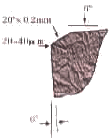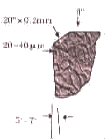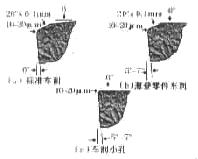Abstract: This paper introduces the processing materials suitable for PCBN tools, as well as the reasonable selection methods of tool geometry parameters, cutting amount and blade number . The specific improvement measures for the common wear and damage forms of PCBN tools in actual machining are proposed .
PCBN is a superhard material obtained by sintering selected CBN crystals under high temperature and high pressure. The blade made of PCBN material has extremely high hardness and good red hardness (can withstand high temperature of 1400-1500 °C), oxidation resistance (no chemical reaction with iron-based metal at 1200-1300 °C) and resistance Fracture toughness is the ideal tool for cutting ferrous materials. At present, PCBN tools have been widely used in processing difficult-to-machine materials such as hardened steel, chilled cast iron, thermal spray materials, pure nickel and precision machining, and have achieved remarkable technical and economic benefits. With the continuous expansion of the application range of PCBN tools, the correct and reasonable selection of PCBN tools to solve various problems in processing in a timely manner has become a powerful guarantee for giving full play to the maximum processing benefits of PCBN tools.
PCBN tools are mainly suitable for processing all kinds of high-hard materials (such as cold work tool steel, hot work tool steel, high speed steel, bearing steel, hardened steel, powder smelting steel, powder smelting metal, martensitic stainless steel, high strength steel, High manganese steel, white cast iron, austenitic soft iron, etc.), soft materials and wear resistant materials (such as gray cast iron, sintered iron, etc.), difficult to process materials (such as Inconel718, case hardened alloy, sintered WC, ductile iron, CGI, etc.). Certain materials or processing conditions (such as typical mild steel, austenitic or ferritic stainless steel, high chromium steel or surface chrome-plated materials, high-speed steel with interrupted cutting, iron-based surface hardening alloys, etc.) are easy to cause PCBN inserts are subject to abnormal chemical wear and are therefore not suitable for PCBN tooling.
The selection of tool geometry and cutting amount has a great influence on the cutting performance, service life and surface quality of the tool. In order to give full play to the excellent performance of the PCBN tool and achieve the desired cutting effect, it is necessary to select the tool geometry and the cutting amount according to the specific processing object. When selecting the geometric parameters of the PCBN tool, the blade edge and the tip strength should be considered. PCBN tools often use a 0° rake angle or a negative rake angle, and grind a negative reverse edge to increase the cutting edge strength; g o1 = -8° ~ -20°; to increase the tip strength, grind g e = The cutting edge arc of 0.2 to 0.8 mm; the back angle is generally small (5° to 7°), and the blade inclination angle is mostly 0°. For different materials to be machined and cutting conditions, the tool geometry should be determined by cutting tests. The tool geometry angles of the PCBN tool roughing and finishing hardened steel are shown in Figures 1 and 2, respectively.
The cutting amount of the PCBN tool should be selected according to the machine tool used, the blade grade, the workpiece to be machined and other processing conditions. Table 1 shows the recommended cutting amounts for Seco's CBN300 inserts (90% CBN, 22 μm grain size, Al binder) for cutting different materials.
The correct choice of PCBN insert grade is the key to the tool's ability to achieve optimum cutting performance. Table 2 shows the characteristics of Seco's various grades of PCBN inserts. Figure 3 is a flow chart showing the selection of PCBN blade grades.
PCBN tools produce normal wear and abnormal wear during use. The normal wear forms of PCBN tools mainly include oxidative wear, phase change wear, friction wear, bond wear, micro-cracking wear, peeling wear, etc., and various wear factors affect each other and promote each other. The influencing factors of abnormal wear of PCBN tools mainly include improper cutting amount and blade geometry parameters, and insufficient rigidity of the processing system. In order to improve the service life of PCBN tools, the following specific measures can be taken to improve the wear patterns and damage phenomena common to PCBN tools in actual use:
The success of the PCBN tool depends not only on the quality of the tool itself, but also on the various aspects of the entire machining system, such as the pros and cons of the machine tool, the reliability of the workpiece clamping, the rigidity of the tool bar system, the rationality of the blade selection, The selection of cutting parameters and the like will affect the cutting effect of the PCBN tool. Only the correct and reasonable use of PCBN tools can improve processing efficiency, reduce production costs, and maximize technical and economic benefits.
1 Introduction
PCBN is a superhard material obtained by sintering selected CBN crystals under high temperature and high pressure. The blade made of PCBN material has extremely high hardness and good red hardness (can withstand high temperature of 1400-1500 °C), oxidation resistance (no chemical reaction with iron-based metal at 1200-1300 °C) and resistance Fracture toughness is the ideal tool for cutting ferrous materials. At present, PCBN tools have been widely used in processing difficult-to-machine materials such as hardened steel, chilled cast iron, thermal spray materials, pure nickel and precision machining, and have achieved remarkable technical and economic benefits. With the continuous expansion of the application range of PCBN tools, the correct and reasonable selection of PCBN tools to solve various problems in processing in a timely manner has become a powerful guarantee for giving full play to the maximum processing benefits of PCBN tools.
 (a) Standard turning |  (b) Profile turning |
| Fig.1 Geometric angle of PCBN tool when roughing hardened steel | |
 Figure 2 Geometric angle of PCBN tool when finishing hardened steel | |
2 Suitable processing materials for PCBN tools
PCBN tools are mainly suitable for processing all kinds of high-hard materials (such as cold work tool steel, hot work tool steel, high speed steel, bearing steel, hardened steel, powder smelting steel, powder smelting metal, martensitic stainless steel, high strength steel, High manganese steel, white cast iron, austenitic soft iron, etc.), soft materials and wear resistant materials (such as gray cast iron, sintered iron, etc.), difficult to process materials (such as Inconel718, case hardened alloy, sintered WC, ductile iron, CGI, etc.). Certain materials or processing conditions (such as typical mild steel, austenitic or ferritic stainless steel, high chromium steel or surface chrome-plated materials, high-speed steel with interrupted cutting, iron-based surface hardening alloys, etc.) are easy to cause PCBN inserts are subject to abnormal chemical wear and are therefore not suitable for PCBN tooling.
3 PCBN tool geometry parameters and reasonable choice of cutting amount
The selection of tool geometry and cutting amount has a great influence on the cutting performance, service life and surface quality of the tool. In order to give full play to the excellent performance of the PCBN tool and achieve the desired cutting effect, it is necessary to select the tool geometry and the cutting amount according to the specific processing object. When selecting the geometric parameters of the PCBN tool, the blade edge and the tip strength should be considered. PCBN tools often use a 0° rake angle or a negative rake angle, and grind a negative reverse edge to increase the cutting edge strength; g o1 = -8° ~ -20°; to increase the tip strength, grind g e = The cutting edge arc of 0.2 to 0.8 mm; the back angle is generally small (5° to 7°), and the blade inclination angle is mostly 0°. For different materials to be machined and cutting conditions, the tool geometry should be determined by cutting tests. The tool geometry angles of the PCBN tool roughing and finishing hardened steel are shown in Figures 1 and 2, respectively.
The cutting amount of the PCBN tool should be selected according to the machine tool used, the blade grade, the workpiece to be machined and other processing conditions. Table 1 shows the recommended cutting amounts for Seco's CBN300 inserts (90% CBN, 22 μm grain size, Al binder) for cutting different materials.
|
|
 Figure 3 PCBN blade grade selection flow chart |
4 PCBN blade grade selection
The correct choice of PCBN insert grade is the key to the tool's ability to achieve optimum cutting performance. Table 2 shows the characteristics of Seco's various grades of PCBN inserts. Figure 3 is a flow chart showing the selection of PCBN blade grades.
5 PCBN tool common grinding (breaking) damage form and improvement measures
PCBN tools produce normal wear and abnormal wear during use. The normal wear forms of PCBN tools mainly include oxidative wear, phase change wear, friction wear, bond wear, micro-cracking wear, peeling wear, etc., and various wear factors affect each other and promote each other. The influencing factors of abnormal wear of PCBN tools mainly include improper cutting amount and blade geometry parameters, and insufficient rigidity of the processing system. In order to improve the service life of PCBN tools, the following specific measures can be taken to improve the wear patterns and damage phenomena common to PCBN tools in actual use:
- Rake wear (See Figure 4)
- Crescent tooth wear (See Figure 5)
- Cutting sniper (See Figure 6) Improvement measures: 1 increase the cutting speed; 2 reduce the cutting feed rate; 3 improve the cutting angle of the tool (such as the use of round blades, etc.).
- Blade breakage (See Figure 7)
- Blade rake flakes during milling (See Figure 8)
- The knife edge is severely chipped (See Figure 9)
Improvement measures: 1 increase the cutting line speed; 2 increase the workpiece feed rate; 3 increase the cutting depth; 4 check whether the cutting point of the blade is at the center height; 5 if the material to be processed is cast iron, check whether the ferrite content is Within the control range.
Improvement measures: 1 reduce the cutting speed; 2 reduce the workpiece feed rate.
 Figure 4 flank wear pattern of PCBN insert |  Figure 5 PCBN blade crater wear pattern |  Figure 6 PCBN blade cutting slamming phenomenon |
 Figure 7 PCBN blade edge collapse phenomenon |  Figure 8 PCBN blade rake peeling phenomenon |  Figure 9 PCBN blade edge is severely chipped |
Improvement measures: 1 use blade with reversed edge or grinding edge; 2 reduce cutting speed or avoid interrupted cutting as much as possible; 3 improve process system rigidity; 4 if interrupted cutting is unavoidable (such as machining surface with holes, grooves Etc), the corresponding cutting entry should be pre-chamfered; 5 change the cutting line speed to optimize the cutting condition and avoid vibration.
Improvement measures: 1 reduce the cutting angle of the tool (preferably less than 20 °); 2 use the up-cut method as much as possible; 3 avoid the use of coolant; 4 increase the cutting speed.
Improvement measures: 1 reduce the cutting depth or machining allowance to reduce the cutting load; 2 reduce the cutting speed; 3 appropriately increase the corner radius of the tool tip (even round blade); 4 use a blade that passes through the reverse edge or the grinding edge; 5 Check that the blade is installed correctly and reliably, and that the mounting surface is intact (especially the overall CBN blade); 6 Check that the cutting center height of the cutting edge is correct.
6 Conclusion
The success of the PCBN tool depends not only on the quality of the tool itself, but also on the various aspects of the entire machining system, such as the pros and cons of the machine tool, the reliability of the workpiece clamping, the rigidity of the tool bar system, the rationality of the blade selection, The selection of cutting parameters and the like will affect the cutting effect of the PCBN tool. Only the correct and reasonable use of PCBN tools can improve processing efficiency, reduce production costs, and maximize technical and economic benefits.
Dc Axial Fan 40X40X20,Mini Battery Dc Fan,Handheld Air Cooling Fan,Dc Main Machine Cooling Fan
Crown Electronics CO., LTD , https://www.crownelectronicstw.com
